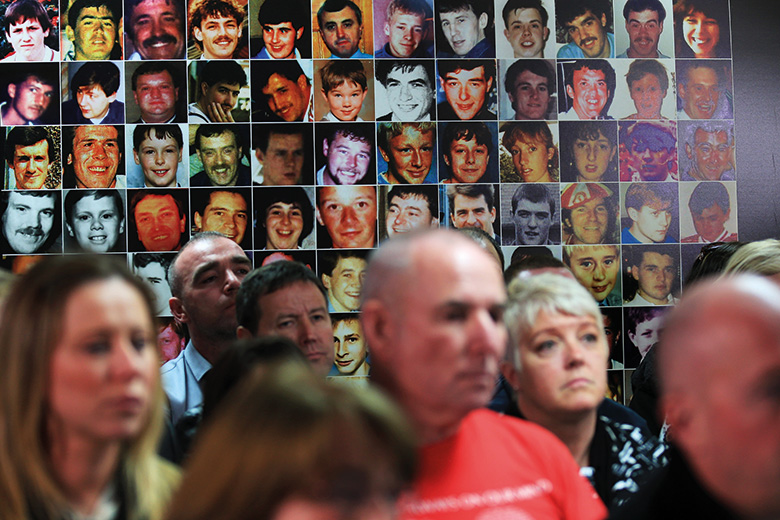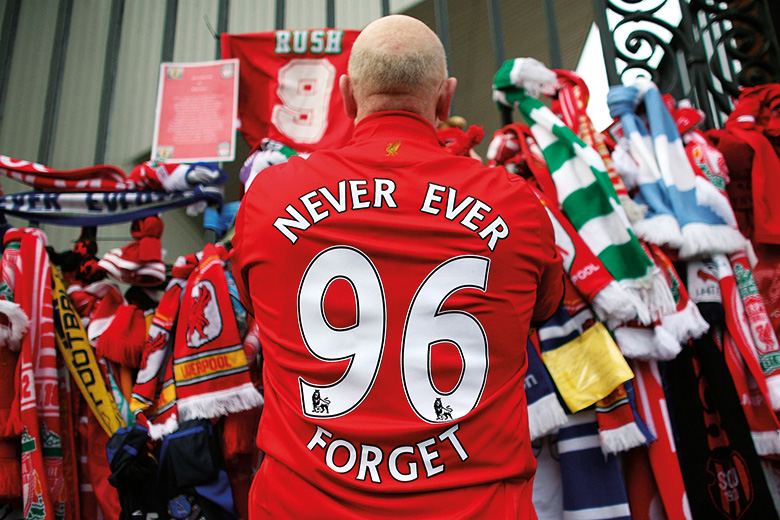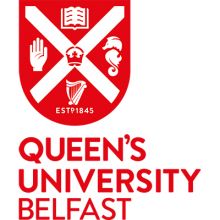On 26 April 2016, history was made in Building 305, an unassuming office block on Birchwood Park Industrial Estate near Warrington in northwest England. The ground floor had been converted into a courtroom to accommodate the longest inquest in English legal history. During the previous 24 hours, the world’s media had laid siege in anticipation of the jury’s verdict on when, where and how 96 Liverpool supporters – men, women and children – had died in a crush at Sheffield’s Hillsborough football stadium 27 years earlier.
As the nine jury members filed in, the atmosphere among the bereaved families and survivors, packed into the courtroom and various overspill locations connected by video link, was one of silent anticipation. I sat behind Margaret Aspinall, chair of the Hillsborough Family Support Group, flanked by her husband and one of her sons. The coroner, a High Court judge, faced the phalanx of legal representatives knowing that the events of the next few minutes would draw a relatively abrupt conclusion to a year’s preliminary hearings and two years of evidence. His summing-up alone had lasted two months.
The verdict’s length and complexity was such that the jury forewoman remained seated. Straight to the point, the coroner asked a series of questions previously agreed with the multiple legal teams. For example, had there been error or omissions in police planning and preparation, in the operational order, in policing on the day or in the decisions taken by commanding officers? It is difficult to recreate the rising emotional crescendo in the room as each question was affirmed. The families held hands, their eyes transfixed on the jury forewoman. “Are you satisfied, so that you are sure, that those who died in the disaster were unlawfully killed?” the coroner asked. “Yes,” she replied. The next question was crucial. “Was there any behaviour on the part of football supporters which caused or contributed to a dangerous situation?” Her voice was firm and unwavering: “No.”
A wave of relief, of exoneration, swept through the court. Still attempting to write my notes, I broke down, comforted by the families around me. In the overspill rooms, family members, survivors and friends were on their feet cheering, hugging and crying. Families’ lawyers were profoundly affected, while other legal teams sat stone-faced. The coroner brought the court to order as there was more to hear from the jury. Ground safety had been seriously compromised; there had been omissions by the owners, their safety engineers and Sheffield City Council. The police had failed to respond to the unfolding crisis, delayed declaring it a major incident and lacked coordination, communication, command and control. And the ambulance service had failed to call an emergency, thereby delaying rescue and evacuation. A catalogue of failures.
At 3pm on 15 April 1989, Liverpool kicked off against Nottingham Forest in the semi-final of the FA Cup. As was routine for big matches, it was played at a neutral venue: Hillsborough, the home of South Yorkshire club Sheffield Wednesday. A Liverpool fan since childhood, I was sitting at home on that sunny afternoon, the television on in the background; it was showing the world snooker championship, also held in Sheffield. Within minutes, our Paul, nine at the time, shouted that something terrible was happening at Hillsborough. The snooker had been interrupted: live pictures showed Liverpool fans attempting to climb from the pens behind the goal. On the pitch, others were trying to resuscitate lifeless bodies, tearing down advertising hoardings to use as makeshift stretchers.
Even as the unconscious were dragged from the pile of bodies, the fans were publicly blamed. Within minutes, a statement from South Yorkshire Police’s match commander, chief superintendent David Duckenfield, was broadcast worldwide. He claimed Liverpool fans had broken through an exit gate, rushed down a steep tunnel into the already packed central pens, causing a fatal crush at the front. Without pause for thought, Jacques Georges, president of football’s world governing body, Fifa, condemned the “frenzy” of the fans. He likened them to “beasts ready to charge into the arena”.
Hours later, in Liverpool, I met returning fans. Shocked and distraught, their near-death experiences were consistent, universally contradicting Duckenfield’s claims. Arriving at the decrepit Leppings Lane turnstiles, a well-known and dangerous bottleneck through which more than 20,000 fans had to pass, they said the congestion had been so severe and poorly managed that the police had opened an exit gate. Fans were funnelled into the stadium, unstewarded and without direction, to descend the tunnel opposite one of the gates into the rear of two pens. There was no escape to the sides, nor over the spiked fence at the front, nor back up the tunnel. Compression was so severe that a safety barrier collapsed.
By mid-evening, Duckenfield had conceded that no gates had been forced. But it was too late. His lie had been broadcast internationally, a vindictive narrative created. The consolidating police story was that Liverpool fans had been unmanageable, many arriving late and without tickets, drunk and violent. Within 24 hours, 95 had died (Tony Bland remained in a persistent vegetative state). Another 400 had been injured and thousands traumatised. Public condemnation was fuelled further by Brian Clough, the Nottingham Forest manager, who said: “Liverpool people killed Liverpool people.”
Well before the funerals, and without hesitation, the print media’s collective, unsubstantiated vitriol was unleashed. Columns and editorials condemned “yobbism at its most base” and “uncontrolled fanaticism and mass hysteria”. The Sun cleared its front page to proclaim “THE TRUTH”. “Some fans picked pockets of victims,” it claimed. “Some fans urinated on the brave cops. Some fans beat up PC giving kiss of life.” A “high-ranking police officer” alleged that a dying young woman had been subjected to fans’ verbal sexual abuse: “Fans were just acting like animals,” he was reported to have said. Public opinion was being shaped by a police version of the disaster’s causes, transmitted by a compliant media.
But that narrative was rejected by Lord Justice Taylor, who was appointed by the Home Office to lead a judicial inquiry and who published his interim report within three months. He concluded that the “main cause” of the Hillsborough disaster was overcrowding, the “main reason” being a profound failure in police control. While strongly criticising Sheffield Wednesday and Sheffield City Council, his most damning judgment was directed towards the police. He considered it “a matter of regret that South Yorkshire Police were not prepared to concede that they were in any way at fault for what had occurred”. Senior officers had been “defensive” and “evasive”. Duckenfield’s “lack of candour” had “set off a widely reported allegation”, knowing it to be false.
A year on, however, the director of public prosecutions concluded that there was no evidence to justify criminal proceedings against the police, Sheffield Wednesday, the safety engineers or the local authority. Further, there was “insufficient evidence” to justify proceedings against any individual, including senior police officers.
In November 1990, the inquests resumed, and remained in session until March 1991. The families received no legal aid. Controversially, the coroner, on whose direction blood alcohol levels of the deceased, including children, had been taken and published, imposed a 3.15pm cut-off on evidence, asserting that by that time all who ultimately died had been beyond rescue. He offered the jury two possible verdicts: unlawful killing and accidental death, weighting his direction heavily towards the latter. Sure enough, on the 80th day of the generic hearings, the jury returned a majority verdict of accidental death.
Families and survivors were devastated. In late 1993, their desolation was compounded when their judicial review of the coroner’s verdict failed in the High Court. The inquests were deemed to have been properly conducted and evidence had not been suppressed. The coroner’s direction had been “impeccable”.

Four years later, under intense pressure from families and survivors, Labour home secretary Jack Straw commissioned a “scrutiny” of “new” evidence, headed by former MI6 commissioner Lord Justice Stuart-Smith. Following extensive interviews with bereaved families and a “review” of documentary evidence, he concluded that there was nothing further to be added to the existing verdicts and rulings. A further three years on, a private prosecution of Duckenfield and his assistant, Bernard Murray, found that the latter had no case to answer. On the charge of manslaughter against Duckenfield, the jury was undecided. The judge ruled against retrial and, with that, the families believed the end of the road had been reached.
In the mid-1970s, on the invitation of a Roman Catholic chaplain at the University of Liverpool, I monitored the eviction of Irish travellers from a derelict site in the city. Bailiffs, no more than hired hands for the day, turned families out of their homes and dragged their caravans from the site. Mothers and children screamed with fear as passive police officers stood by. Ostensibly, the police presence was to ensure families’ compliance. Yet the peace they kept was one of institutionalised violence and violation that, at the time, extended into working-class communities.
Following the 1979 deaths of Blair Peach – an anti-racist campaigner killed by the police during a demonstration in London – and Jimmy Kelly – who died in the custody of Merseyside Police after allegedly being assaulted by officers following his arrest for being drunk and disorderly – I became a founder member of INQUEST: United Campaigns for Justice, a charity aimed at monitoring and responding to deaths in custody.
Uprisings within black communities continued throughout the early 1980s, following further deaths in controversial circumstances, and they became the focus of my research. It was clear that in this climate, soon extending to the aggressive policing of mining communities, any last vestige of political accountability regarding operational police policies and their implementation had been lost. Nowhere was this more evident than in South Yorkshire, where attacks on striking miners at Orgreave have, to this day, remained imprinted on families whose livelihoods were so brutally destroyed; it is to the current home secretary’s shame that, last month, she refused a Hillsborough-style inquiry into the so-called Battle of Orgreave.
My research and writing focused on institutional powers and political accountability. It questioned relationships between the academy and communities, social research and political intervention – questions at the heart of critical analysis. As tensions ran high, I recalled Howard Becker’s defining 1967 address to the American Sociology Association, “Whose Side Are We On?”. In understanding and negotiating power relations, Becker had proposed that the role of social scientists was not to determine the existence of “sides” – that was self-evident – but to align themselves with one side or the other.
In the late 1980s, I worked with Joe Sim, now a professor at Liverpool John Moores University, on prisoners’ protests in Scottish prisons. We wrote a critical report based on their written testimonies, and the summary “justice” to which they had been subjected. On the afternoon of 15 April 1989, I was editing those very testimonies for inclusion in our book Prisons Under Protest when our Paul called me to the television.
As the unfounded criticisms of Liverpool fans mounted, I realised the necessity of in-depth analysis into the context, causes and consequences of the Hillsborough disaster. By now, I was in Scotland with our criminology students, conducting research visits in prisons. From a public telephone box, I rang Liverpool City Council to arrange a meeting. The council agreed to fund the “Hillsborough Project” and three researchers – Sheila Coleman, Ann Jemphrey and Paula Skidmore – were appointed.
Within a year, we published our first report. Based on in-depth interviews with bereaved families, we revealed their appalling treatment by the police in the immediate aftermath of the disaster as they identified their loved ones. We raised concerns about the limitations of the Taylor report, arguing that much had been missed regarding the underlying causes of the disaster and the institutional failures of the agencies involved. This drew ire from my local newspaper, its editorial questioning the “usefulness” of our research in light of the cost borne by “city ratepayers”. At work, the impact on my other academic “commitments” was raised in a memo from the director of the university, and senior social workers accused the research team of “winding up” families.
But we pressed on, and in 1995 published a second comprehensive report. It condemned the institutional processes as “corrupt”, their operational practices as “dishonest”. Hillsborough, our report evidenced, amounted to a “grave miscarriage of justice” at every level. But our 87 recommendations concerning crowd safety, policing, institutional responses to the immediate aftermath of disasters and the role and constitution of official inquiries and inquests made no impact.
In 1996, Jimmy McGovern’s award-winning drama-documentary, Hillsborough, produced by the late Katy Jones, was televised. Soon afterwards, I met with a former South Yorkshire police officer. Walking on the Pennine hills, he told me how he and his colleagues had been intimidated by senior officers into editing their official statements about Hillsborough. Eventually, he handed me a bundle of documents. A covering letter from a senior partner in the law firm representing South Yorkshire Police affirmed that statements had been subjected to “review and alteration”. The officer’s statement was in three versions: handwritten, typed with substantial suggested edits and final edited copy. Why had he signed each page of the latter? “It’s my signature but I did not put it there,” he replied.
After that meeting, I eventually negotiated access to all police statements at the House of Lords Reading Room. They had been deposited randomly in battered file boxes. It took days of sorting and matching, but I discovered that, on numerous statements, police investigators had added comments, such as “not a good statement for the SYP [South Yorkshire Police], see officer to review paras”. Comments were initialled, and it appeared that a team had been assigned to the task. At best, the alterations were professionally inappropriate. At worst, they were a corruption of evidence.
The former police officer accompanied me to a meeting with Stuart-Smith. The judge’s hostility was barely concealed. In his subsequent report, he concluded that a “wide ranging inquiry such as advocated by Professor Scraton and some of the families I have spoken to, would clearly impose enormous burdens on the police, the emergency services and the hospital and medical staff…These burdens would in my judgement be to no purpose.” He added that my “allegation of irregularity and malpractice” was “not substantiated”. At that moment, I decided to write Hillsborough: The Truth.
Published in 1999, the book was greeted with universal acclaim. Serialised in the Sunday Mirror newspaper, the full extent of the review and alteration process was laid bare under the banner headline, “The Untold Story: How The Truth was Censored”. In the same edition was a front-page story of how Merseyside’s recently appointed chief constable, Sir Norman Bettison, had played a significant role in the aftermath of the disaster. At the time he had been a South Yorkshire Police chief inspector and had attended the match as a spectator. Within days, he rang my ex-directory number, asking whether I was behind the newspaper story and whether he was named in the book. Although I had met him previously, at that time of writing I was unaware of the full extent of his involvement in coordinating the police’s subsequent account of what went on and why (a role he continues to deny), and I made no reference to him in the first edition. Coinciding with publication, however, I received anonymously a copy of his application to Merseyside. Attached was his CV. Despite the length and detail of such documents, he made no reference in either to his role or duties in the Hillsborough aftermath. A major controversy erupted that focused on the circumstances of his appointment. In the 2000 edition of the book, I analysed the documents, detailing also the ensuing local political fall-out. His role and duties in the aftermath were considered more fully by the Independent Panel. This was reflected in its 2012 report – and in the 2016 edition of Hillsborough: The Truth.

I had anticipated that our extensive research, McGovern’s film and the extensive media coverage would prove once and for all how the police investigations, the inquests, the appeal courts and the subsequent scrutiny had systemically failed the families and survivors. It wasn’t to be, however, and we entered what I characterise as the “fallow decade”. However, the families’ and survivors’ campaign remained resolute.
And on 15 April 2009, more than 30,000 people attended Liverpool’s own stadium, Anfield, to commemorate the 20th anniversary of the Hillsborough disaster. It was a powerful collective statement that the 96 who died, their families and survivors (with whom I had kept in regular contact after moving to Queen’s University Belfast), were not forgotten. For the first time, a politician, local MP and government minister Andy Burnham, had been invited by the Hillsborough Family Support Group to address the crowd. Initially, he was silenced by the crowd’s persistent chant of “justice for the 96”. Yet he went on to praise families’ “dignity”, “resolve” and “remarkable courage” in the face of “major injustice”. That evening he committed the government to ensuring that all state-held documents would be released for scrutiny. The rule preventing such documents from being released within 30 years of being written potentially meant his assurance could not be realised. The rule was revoked.
Within months, the families were invited to submit their case. I drafted their proposal for an independent process that would access and analyse all documents and other relevant material held by all agencies, and produce a full analytical report on the findings. This led to my appointment to head the research for the Hillsborough Independent Panel chaired by James Jones, the Bishop of Liverpool.
Responding to the guiding principle of “maximum public disclosure”, more than 80 organisations submitted documents during the following 30 months. The resulting 395-page report, published in September 2012, was unambiguous: crowd safety had been compromised by institutional complacency and neglectful custom and practice; the Leppings Lane access and egress, outside and inside the stadium, were inherently unsafe; the stadium failed comprehensively to meet minimum safety requirements; the prevailing mind-set shared by the South Yorkshire Police and Sheffield Wednesday prioritised crowd regulation over crowd safety; there was a failure by the ambulance service to recognise the crisis in the pens; the pathologies had been rushed and insubstantial; in conception, process and outcome, the inquests and their verdicts were profoundly flawed; senior police officers had orchestrated negative media coverage in the immediate aftermath; the review and alteration of statements had corrupted police evidence and had also extended to ambulance officers’ statements; and no evidence existed “to verify the serious allegations of exceptional levels of drunkenness, ticketlessness or violence among Liverpool fans”.
Within an hour of my detailed presentation of the panel’s report to the families in Liverpool’s Anglican Cathedral, the prime minister, David Cameron, delivered an emotional “double apology” in Parliament to the bereaved families, “for all they have suffered over the past 23 years”. First, there was the “injustice of the appalling events – the failure of the state to protect their loved ones and the indefensible wait to get to the truth”; second, there was “the injustice of the denigration of the deceased…that somehow they were at fault for their own deaths”. Echoing her leader’s comments, home secretary Theresa May stated her intention to act on the panel’s “comprehensive…shocking and disturbing” findings, to ensure progress “from truth to justice”.
The Crown Prosecution Service established a major criminal investigation led by a retired chief constable and staffed by more than 100 officers. In response to the Independent Panel’s revelations of “extremely serious and troubling issues for the police”, the Independent Police Complaints Commission embarked on an ongoing investigation into misconduct that is unprecedented in its size and scope. A full review of all disaster emergency response procedures was also ordered. Finally, the High Court quashed the accidental death verdicts and ordered new inquests that would shine a “light” on the “truth”. Through this process, “the families of those who died in the disaster will be vindicated and the memory of each victim will be properly respected”.
On 31 March 2014, the new inquests opened before an 11-person jury. At the preliminary hearings, several counsel representing police interests were clear that, although they acknowledged that the behaviour of the 96 who died was beyond reproach, they would nevertheless resurrect the allegations discredited by the Independent Panel that fans arrived ticketless and late, drank excessively and behaved uncontrollably. While the coroner stated that the inquests should not descend into an “adversarial battle”, the battle lines were drawn. Two years on, the jury, now reduced to nine, returned its groundbreaking verdict.
The bereaved families’ and survivors’ 27-year campaign for justice is a remarkable demonstration of resilience. Many have died prematurely, their illnesses brought on or worsened by the pain and suffering of bereavement, compounded by the devastation of injustice. For critical social analysts, Hillsborough raises fundamental questions about institutional power and, to acknowledge the work of Michel Foucault, how the state mobilises “regimes of truth” to deflect, diminish and defeat oppositional discourses. We should always start with the “knowing” question: how we know what we know. This demands viewing official statements and popular narratives through a sceptical lens, and seeking out dissenting accounts and alternative discourses. Central to this is hearing the “view from below”, recovering truth through promoting alternative accounts silenced by official reports and hostile journalism. There is profound public interest in establishing the “right to truth”: in exposing the institutional failings in so-called due process of the law.
The Hillsborough research, in its three decades of breadth, depth and intensity, also raises fundamental questions about how critical research and publication is viewed within the academy. None of its research reports, including the tour de force that is the Independent Panel’s report, nor Hillsborough: The Truth, were considered appropriate or worthy for inclusion in my institution’s research excellence framework submission. Although the research received the highest grade for “research impact”, it is regrettable, at best, that the scholarship behind it – reflected in extensive publication – was deemed unworthy. Such marginalisation can only harm early career academics’ aspirations to embark on revelatory and essential critical research into state institutions.
Phil Scraton is professor of criminology at Queen’s University Belfast and was recently visiting professor at the universities of Auckland in New Zealand and New South Wales in Australia. In September he was awarded the Freedom of Liverpool, his home city, and this month he will be awarded an honorary Doctor of Laws by the University of Liverpool. This week, he and Margaret Aspinall, chair of the Hillsborough Family Support Group, received the Political Studies Association’s Campaigners of the Year Award.
POSTSCRIPT:
Print headline: Researching ‘truth’, delivering ‘justice’
Register to continue
Why register?
- Registration is free and only takes a moment
- Once registered, you can read 3 articles a month
- Sign up for our newsletter
Subscribe
Or subscribe for unlimited access to:
- Unlimited access to news, views, insights & reviews
- Digital editions
- Digital access to THE’s university and college rankings analysis
Already registered or a current subscriber? Login








